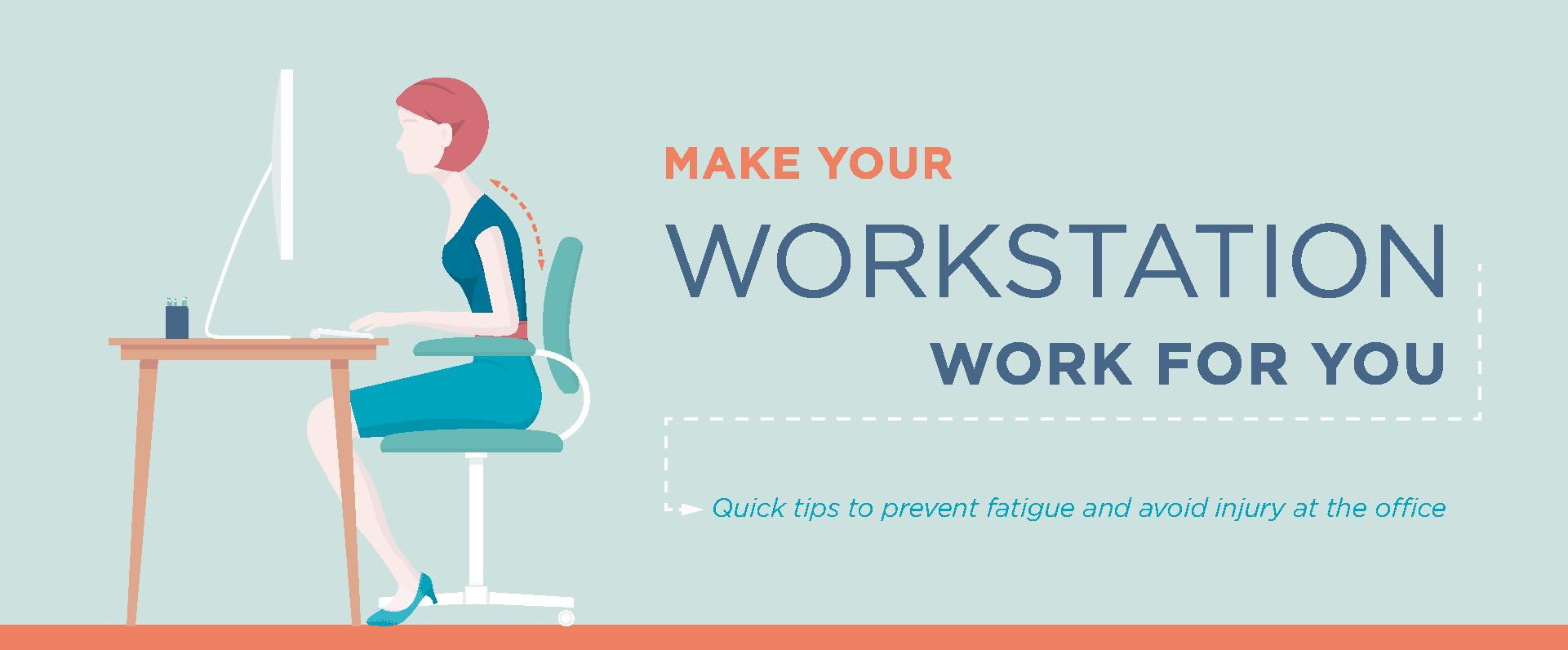
Americans are spending more time than ever sitting at our desks, in meetings or on conference calls.
While the simple act of sitting all day may seem harmless, the truth is that spending hours on end on our rear ends can wreak havoc on both our bodies and our productivity, especially when our workstations aren’t set up for optimal comfort.
From eye strain to headaches to carpal tunnel symptoms, a number of obvious and not-so-obvious injuries can occur over time from keeping an improperly configured workspace.
If you haven’t given much thought to where you spend the majority of your day, it may be time to take a good look at your work environment and give it (along with your work habits) a much-needed makeover.
Make work as comfortable as possible with these 5 tips:
1. Check your chair
- Adjust your seat height and angle so that both your feet are flat on the floor with your upper and lower back fully supported. Add an inflatable cushion or small pillow if needed.
- Make sure your arm rests allow your shoulders to relax and your elbows to stay easily bent around a 90-degree angle.
- Push your hips back as far as they can go in the chair.
2. Keys to the keyboard
- Position the keyboard directly and closely in front of you—not slightly off to the side or far out in front of you to where you have to straighten your arms to reach it.
- Adjust the keyboard height so your shoulders remain relaxed and your elbows slightly open.
- Place the mouse as close to the keyboard as possible.
3. Monitor your monitor
- Center all screens directly in front and slightly above the keyboard. Position the top of the monitor approximately 2-3 inches above your seated eye level.
- Sit at least an arm’s length away from the screen.
- Reduce screen glare by lowering the brightness or using a glare filter or anti-glare glasses.
4. Hold the phone
- Place the phone within easy reach of your computer.
- Use a headset or take calls on speakerphone to reduce cradling the handset with your neck.
- Schedule in-person meetings whenever possible.
5. Check yourself
- Don’t slouch. This may seem obvious, but it’s easy to let our posture slip when sitting all day or absorbed in our work. While adjusting your chair will help you maintain a proper position, it’s also important to remain mindful of your posture. Make it a point to sit up completely straight, keeping your elbows close to your body and your wrists facing forward. Frequently adjust your position whenever you notice it shift.
- Take breaks. Yes, we’re giving you permission—and in fact encourage you—to take frequent breaks! Ideally, you want to stand up and take at least a five minute break away from your computer every 30-60 minutes. We understand that’s not always realistic or even possible, in which case, strive to abide by the 20-20-20 rule: Every 20 minutes, take 20 seconds to look at something that’s 20 feet away from you.
- Protect your peepers: Eyestrain is often downplayed, but its effects are very real, especially since our eyes aren’t designed to stare at screens all day. Beyond just hurting our orbitals, lack of proper eye care can also lead to tension headaches and sore muscles. Block the screen’s harmful rays by either turning down brightness or investing in a screen filter or anti-glare glasses—which are actually surprising stylish.
- Stretch it out: You know those people on planes who walk or do lunges down the aisles during long flights? We want you to be those people at the office! Help prevent injuries, improve circulation (and maybe even help yourself get toned!) by stretching out your neck, shoulders, and arms 2-3 times a day.
While these tips may seem obvious or even minor, they make a proven world of difference when actively regarded! Your (healthy) body—and (optimal) work productivity—thank you in advance!


